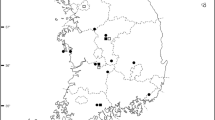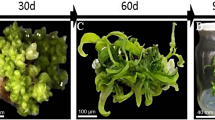Abstract
A detailed account is presented of attendant polysomatic variation in planta and elucidation of the modal karyotype in the difficult-to-study endangered orchid Bulbophyllum auricomum, known as the Royal Flower of Myanmar. The somatic chromosome number of B. auricomum (2n = 38) is reported for the first time. Polysomaty was prevalent in all seed-derived plants studied except two (SC34 and SC42). It was noted that in addition to normal diploid cells occurring in different frequencies (60% in SC21 to 89% in SC22, SC35), root tip cells also showed chromosome numbers <38 (in 0–37% metaphases) and >38 (in 0–33% metaphases). The chromosomes of B. auricomum are very small (0.7–2.7 μm) in size. The karyotype of diploid B. auricomum showed 34 chromosomes with primary constriction (14 M + 16 m + 4sm) and 4 chromosomes with secondary constrictions (sm:sm). Of the 50 plants analyzed, 2 (SC34 and SC42) were polyploid, showing 70 and 62 chromosomes in the root tip cells. The polyploidization in seed-derived plants clearly indicates the heterogeneous nature of orchid seed stock. Early detection of polyploidization in in vitro–propagated B. auricomum is valuable for conservation of this native endangered orchid species. On the other hand, the clonally propagated plants retained the chromosomal status of parent plants. This protocol could be exploited to protect this native endangered orchid species from natural extinction.



Similar content being viewed by others
References
Allendorf FW, Leary RF, Spruell P, Wenburg JK (2001) The problems with hybrids: setting conservation guidelines. Trends Ecol Evol 16:613–622
Appels R, Morris R, Gill BS, May CE (1998) Chromosome biology, 1st edn. Kluwer, Canberra
Arditti J (2008) Micropropagation of orchids, 2nd edn. Wiley, New York
Arends JC, Van Der Berg WJ, Van Der Laan FM (1980) Notes on African orchids. Misc. paper 19. Landbouwhogeschool, Wageningen, pp 23–36
Arora CM (1971) IOPB chromosome number report 34. Taxon 20:785–797
Augustine J, Kumar Y, Sharma J (2001) Orchids of India. II. Biodiversity and status of Bulbophyllum Thou. Daya, New Delhi
Biswas BK (1980) In IOPB chromosome number report LXVI. Taxon 29:163–169
Biswas BK, Sharma AK (1979) Some indications of evolution in the genus Paphiopedilum (Orchidaceae). Evol Bot Biostratigr 1979:195–201
Brandham P (1999) Cytogenetics. In: Pridgeon AM, Cribb PJ, Chase MW, Rasmussen FN (eds) Genera Orchidacearum, vol 1. Oxford University Press, Oxford, pp 67–80
Chardard R (1963) Contribution a l’ètude cyto-taxonomique des Orchidees. Rev Cyt Biol Veg 26:1–58
Chatterji AK (1966) Polysomaty in orchids. Die Naturwissenschaften 19:509–510
Chatterji AK (1968) Chromosome numbers and karyotypes of some orchids. Bull Am Orchid Soc 37:202–205
Chaudhuri RK, Pal A, Jha TB (2007) Production of genetically uniform plants from nodal explants of Swertia chirata Buch. Ex Wall.—an endangered medicinal herb. In Vitro Cell Dev Biol Plant 43:467–472
Chaudhuri RK, Pal A, Jha TB (2009) Regeneration and characterization of Swertia chirata Buch.-Ham. ex Wall. plants from immature seed cultures. Sci Hortic 120:107–114
Chen YC, Chang C, Chang WC (2000) A reliable protocol for plant regeneration from callus culture of Phalaenopsis. In Vitro Cell Dev Biol Plant 36:120–123
Chugh S, Guha S, Rao IU (2009) Micropropagation of orchids: a review on the potential of different explants. Sci Hortic 122:507–520
Cullis CA (1999) Environmental stress—a generator of adaptive variation? In: Lerner HR (ed) Plant adaptations to stress environments. Marcel Dekker, New York, pp 149–160
Daker MG (1970) The chromosomes of orchids IV. Bulbophyllinae Schltr. Kew Bull 24:179–184
Daviña JR, Grabiele M, Cerutti JC, Hojsgaard DH, Almada RD, Insaurralde IS, Honfi AI (2009) Chromosome studies in Orchidaceae from Argentina. Genet Mol Biol 32:811–821
Dobzhansky T (1951) Genetics and the origin of species. Columbia University Press, NewYork
Dressler RL (1993) Phylogeny and classification of the orchid family. Dioscorides, Portland
Duval MF, Bory S, Andrzejewski S, Grisoni M, Besse P, Causse S (2006) Diversite genetique des vanilliers dans leurs zones de dispersion secondaire. In: Les ressources génétiques: des ressources partagées: 6ème Colloque national BRG, La Rochelle, 2–4 October 2006. BRG, Paris, pp 181–196
Ebert I, Greilhuber J, Speta F (1996) Chromosome banding and genome size differentiation in Prospera (Hyacinthaceae). Plant Syst Evol 203:143–177
Frankham R, Ballou JD, Briscoe DE (2002) Introduction to conservation genetics. Cambridge University Press, Cambridge
Goldman DH, Jansen RK, Van Den Berg C, Leitch IJ, Fay MF, Chase MW (2004) Molecular and cytological examination of Calopogon (Orchidaceae, Epidendroideae): circumscription, phylogeny, polyploidy and possible hybrid speciation. Am J Bot 91(5):707–723
Grant V (1981) Plant speciation, 2nd edn. Columbia University Press, New York
Jones K (1974) Cytology and the study of orchids. In: Withner CL (ed) The orchids: scientific studies. Wiley, New York, pp 383–389
Kamemoto H, Tanaka R, Kosaki K (1961) Chromosome numbers of orchids in Hawaii. Univ Hawaii Agri Exp Sta Bull 127:5–28
Kondo K (1990) Chromosome numbers of some Chinese species of Camellia. Bull Seibu Maizuru Bot Inst 5:1–9
Kondo K, Alam SS, Tanaka R, Takaki S, Kojima K, Hashimoto K (1993) Spontaneous occurrence of tetraploid and triploid plants in diploid cultivated-population of Phalaenopsis amabilis (Orchidaceae). Kromosomo II 69:2355–2359
Lavania UC (2002) Chromosome diversity in population: defining conservation units and micro-identification through genomic in situ painting. Curr Sci 83(2):124–127
Levan A, Fredga K, Sandberg AA (1964) Nomenclature for centromeric position on chromosomes. Hereditas 52:201–220
Lim KY, Jones K (1982) The chromosomes of orchids VI. Bulbophyllum. Kew Bull 37(2):217–219
Löve A, Löve D (1967) Polyploidy and altitude: Mt. Washington. Biol Zentralbl Suppl 86:307–312
Malla SB, Bhattarai S, Gorkhali M, Sanju H (1977) In IOPB chromosome number report LVII. Taxon 26:443–452
Masterson J (1994) Stomatal size in fossil plants: evidence for polyploidy in majority of angiosperms. Science 264:421–423
Mehra PN, Kashyap SK (1979) In IOPB chromosome number report LXIV. Taxon 28:391–408
Mehra PN, Pandita JK (1978) In IOPB chromosome number report LXI. Taxon 27:315–392
Mehra PN, Sehgal RN (1980) In IOPB chromosome number report LXVII. Taxon 29:347–367
Mehra PN, Vij SP (1970) In: Löve A (ed) IOPB chromosome number reports XXV. Taxon 19:106–111
Murashige T, Skoog F (1962) Revised medium for rapid growth and bioassays with tobacco tissue cultures. Physiol Plant 15:473–497
Murray BG, Young AG (2001) Widespread chromosome variation in the endangered grassland forb Rutidosis leptorrhynchoides F. Muell. (Astaraceae: Gnaphalieae). Ann Bot 87:83–90
Nair RR, Ravindran PN (1994) Somatic association of chromosomes and other mitotic abnormalities in Vanilla planifolia (Andrews). Caryologia 47:65–73
Pancho JV (1965) Orchidaceae in International Organization of Plant Biosystematists (I.O.P.B.) chromosome number reports: III. Taxon 14:52–57
Parker JS, Lozano R, Taylor S, Ruiz Rejón M (1991) Chromosome structure of populations of Scilla autumnalis. Heredity 67:287–297
Semple JC, Chmielewski JG, Windham MD (1989) Chromosome number determinations in fam. Compositae, tirbe Astereae. III. Additional counts and comments on generic limits and ancestral base numbers. Rhodora 91:296–314
Sharma AK (1978) Change in chromosome concept. Proc India Acad Sci 87B:161–190
Sharma AK, Chatterji AK (1966) Cytological studies on orchids with respect to their evolution and affinities. Nucleus 9:177–203
Sharma AK, De DN (1956) Polyploidy in Dioscorea. Genetica 28:112–120
Sharma AK, Sharma A (1956) Fixity in chromosome number of plants. Nature 177:335–336
Sharma K, Mishra AK, Misra RS (2008) The genetic structure of taro: a comparison of RAPD and isozyme markers. Plant Biotechnol Rep 2:191–198
Singh F (1992) Micropropagation of orchids—Spathoglottis plicata and Epidendrum radicans. In: Bajaj YPS (ed) Biotechnology in agriculture and forestry, high-tech and micropropagation IV, vol 20. Springer, Berlin, pp 223–245
Soltis DE, Soltis PS, Schemske DW, Hancock J, Thompson J (2007) Autopolyploidy in angiosperms: have we grossly underestimated the number of species? Taxon 56:13–30
Surenciski MR, Dematteis M, Flachsland EA (2007) Chromosome stability in cryopreserved germplasm of Cyrtopodium hatschbachii (Orchidaceae). Ann Bot Fennici 44:287–292
Tanaka R, Kamemoto H (1984) Chromosomes in orchids: counting and numbers. In: Arditti J (ed) Orchid biology: reviews and perspectives III. Cornell University Press, Ithaca, pp 324–410
Than MMM, Pal A, Jha S (2009) In vitro flowering and propagation of Bulbophyllum auricomum Lindl., the royal flower of Myanmar. Acta Hort 829:105–111
Vij SP, Gupta GC, Grag AK (1976) In IOPB chromosome number report LIV. Taxon 25:631–649
Acknowledgments
M.M.M.T. is thankful to the OWSDW (Formerly the Third World Organization for Women in Science, TWOWS), Italy, for the award of TWOWS fellowship and to the Programme Coordinator, Centre of Advanced Study, Department of Botany, University of Calcutta and Prof. T.B. Jha, Head, Department of Botany, Presidency College for facilities. She is also grateful to Prof. Sumitra Sen for advice and encouragement. Thanks are due to Biplab K. Bhowmick and Mihir Halder for technical help.
Author information
Authors and Affiliations
Corresponding author
Rights and permissions
About this article
Cite this article
Than, M.M.M., Pal, A. & Jha, S. Chromosome number and modal karyotype in a polysomatic endangered orchid, Bulbophyllum auricomum Lindl., the Royal Flower of Myanmar. Plant Syst Evol 294, 167–175 (2011). https://doi.org/10.1007/s00606-011-0459-6
Received:
Accepted:
Published:
Issue Date:
DOI: https://doi.org/10.1007/s00606-011-0459-6




